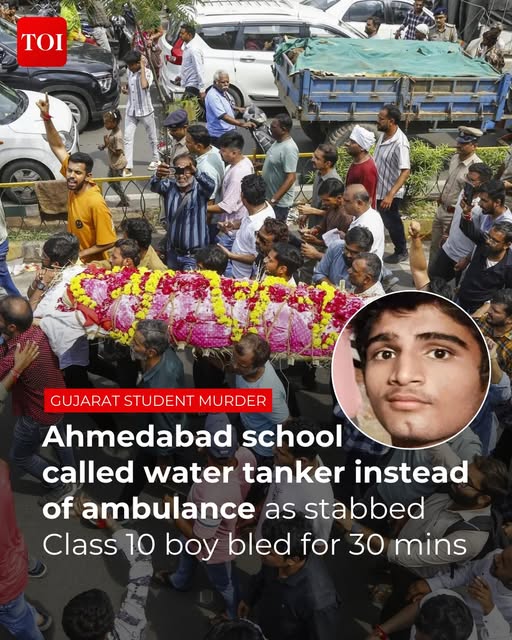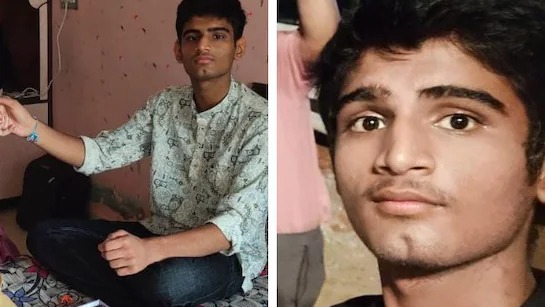The Deadly Mix of Fragile Ego and Fake Heroism Behind Nayan’s Murder
– Atoofa Nasiha
“Who are you? What can you even do?” Does this sentence trigger you to stab the one who asked?
It did trigger the murderer of Nayan Santani, a Class 10 student in Ahmedabad.
The fatal stabbing of Class 10 student Nayan Santani at Maninagar’s Seventh Day Adventist Higher Secondary School has jolted observers into asking painful and necessary questions about the psychological underpinnings of today’s youth.
How Media Shapes Heroism, Ego and the Fragility of Modern Childhood
In the chilling confession, the victim said, “Kon hai kya karlega tu?” (“Who are you? What can you even do?”) to an 8th std student, the murderer. Triggered by the statement, he pursued to stab him to show what he could “actually do”.
This detached bravado reflects a toxic perception of heroism crafted by action-packed movies and streaming series, where defiance, aggression, and instant dominance are glamorised.
 Bollywood blockbusters like Animal, where raw machismo and vengeance are king, and Hollywood franchises like John Wick or The Dark Knight, offer stylised portrayals of justified violence. Such narratives feed into a fragile ego culture, where confrontation becomes equated with power, and emotional regulation is overshadowed by cinematic bravado.
Bollywood blockbusters like Animal, where raw machismo and vengeance are king, and Hollywood franchises like John Wick or The Dark Knight, offer stylised portrayals of justified violence. Such narratives feed into a fragile ego culture, where confrontation becomes equated with power, and emotional regulation is overshadowed by cinematic bravado.
How Parental Shielding Turns into Silence
Many parents, in the name of protection, foster a mindset that their child is beyond reproach. This permissive or entitled parenting, sometimes flagged as “helicopter” or “ghost parenting,” can embolden children into believing they are exempt from discipline or rule. Teachers, wary of parental backlash, may avoid confronting behavioural issues altogether.
Psychological studies on “academic entitlement” report that permissive parenting correlates with higher entitlement in children, which then links to increased stress and declining mental health among adolescents. Similarly, inflated or restricted forms of relational entitlement toward teachers are associated with low school engagement, poor well-being, and maladaptive attitudes.
How Schools Often Become Silent Observers
Teachers often observe troubling behaviour, sibling or peer clashes, aggressive talk, or withdrawn defiance. But when parents interpret any disciplinary feedback as criticism, educators can feel isolated or unsupported. This triggers a cycle where early warning signs remain unaddressed.
Both “ghost parenting” (detached oversight) and overprotective parenting contribute to this, according to reports citing teacher burnout and inadequate school resources.
Psychological Insights on Ego, Media and Observational Learning
Researchers report a broad consensus that exposure to violent media, whether films, TV shows, or video games, increases aggression in children. A survey found 90% of paediatricians, 66% of media psychologists, and 67% of parents agreed on this link. [Gentile, D.A., & Bushman, B. J. (2012). Reassessing media violence effects using a risk and resilience approach to understanding aggression. Psychology of Popular Media Culture, 1(3), 138–151.]
A meta-analysis confirmed that repeated exposure to violent media leads to higher levels of aggressive behaviour, hostile thoughts, emotional arousal, and reduced empathy. It not only raises aggressive thoughts and emotions but also elevates physiological arousal, which can make children more likely to respond aggressively in real-life situations. The findings were consistent across age, gender, and cultural backgrounds. [Anderson, C.A., et al. (2010). Violent video game effects on aggression, empathy, and prosocial behaviour in Eastern and Western countries: A meta-analytic review. Psychological Bulletin, 136(2), 151–173.]
Video games with violent content, such as PUBG, Free Fire, and GTA, have also been linked to increased aggression in children and adolescents. Studies show that repeated exposure to in-game violence elevates hostile thoughts, emotional arousal, and aggressive behaviour, similar to violent movies and TV shows. Players may internalise aggressive scripts, interpreting provocation or conflict as justification for violence. [Anderson, C.A., & Dill, K.E. (2000). Video games and aggressive thoughts, feelings, and behaviour in the laboratory and in life. Journal of Personality and Social Psychology, 78(4), 772–790.]
Social Learning Theory, proposed by Albert Bandura, explains that children learn behaviours by observing others and imitating them, especially when those behaviours appear rewarded or unpunished. His famous Bobo Doll Experiment (1961) demonstrated that children who watched adults act aggressively toward a doll were more likely to imitate the same aggressive behaviour themselves. This study remains one of the clearest demonstrations that exposure to modelled aggression increases the likelihood of aggressive imitation in children. [Bandura, A., Ross, D., & Ross, S. A. (1961). Transmission of aggression through imitation of aggressive models. Journal of Abnormal and Social Psychology, 63(3), 575–582.]
One study analysing decades of films found that homicidal language in movies had nearly doubled between the 1970s and 2020, raising concerns about desensitisation to violence. [Fischer, P., & Greitemeyer, T. (2021). Media violence and the cumulative impact on aggressive thoughts: A longitudinal analysis of violent movie content 1970–2020. Journal of Communication, 71(4), 561–584.]
Exposure to violent media does not just provoke temporary anger. Instead, it can normalise aggression as a socially acceptable response, dull empathy for victims, and engrain cognitive scripts, which are mental blueprints for how to behave during conflict. Once these aggressive scripts are internalised, children may instinctively use them in stressful situations, interpreting provocation as justification for violence. This effect has been supported by longitudinal studies showing that children heavily exposed to violent TV in childhood were more likely to display aggressive and antisocial behaviour in adulthood. [Huesmann, L.R., Moise-Titus, J., Podolski, C.L., & Eron, L. D. (2003). Longitudinal relations between children’s exposure to TV violence and their aggressive and violent behaviour in young adulthood: 1977–1992. Developmental Psychology, 39(2), 201–221.]
Prevention: A Trilogy of Responsibility – Family, Schools, Society
- Family-Level Interventions
Parents are the first teachers of values, empathy, and self-control. When children consume violent media without guidance, they may internalise aggression as normal behaviour. Families can intervene by:
Limiting violent media exposure: Paediatricians recommend no more than 2 hours of screen time per day. But the key is not just time, it’s content. Parents should monitor what their children watch, filter violent or hyper-aggressive shows, and replace them with healthier alternatives.
Co-viewing and discussion: Watching content together and discussing the difference between cinematic fiction and reality helps children process what they see. For example, if a child watches a fight scene, parents can explain that in real life such actions cause lasting harm.
Strengthening emotional resilience: Research shows that strong father-child and mother-child attachments increase ego resilience, reducing the need to “prove strength” through risky or aggressive acts. Families can teach coping mechanisms, healthy expression of anger, and problem-solving skills.
Modelling behaviour: Children imitate adults. Parents who handle disagreements calmly, admit mistakes, and show respect to others indirectly teach conflict resolution better than lectures ever could.
- School-Level Action
Schools are not just centres of learning but also social environments where children form identities and values. Teachers often notice troubling signs early but hesitate due to fear of backlash. Schools can step up by:
Introducing emotional literacy programmes: Workshops on anger management, empathy training, and communication skills can help children regulate their emotions before they escalate into violence. Programmes like Cognitive Behavioural Anger-Control Training (CBACT) have shown effectiveness.
Creating a supportive ecosystem for teachers: Administrators and parents must stand with teachers when they confront problematic behaviour. If parents shield every mistake, schools lose the authority to guide children.
Clear reporting mechanisms: Schools should have safe, confidential ways for students and teachers to report bullying, aggression, or violent tendencies, with timely interventions.
Media literacy education: Students should be taught to critically analyse films, web series, and games identifying unrealistic portrayals of violence and discussing real-world consequences.
- Societal and Cultural Measures
Society plays a vital role in shaping what children see, value, and aspire to. Entertainment and community norms influence youth more than we often admit. Practical steps include:
Promoting media literacy campaigns: NGOs, government, and media houses can run campaigns teaching families and youth to separate fantasy from reality. Ads and school outreach programmes can highlight how violence destroys lives rather than solving problems.
Responsible cinematic storytelling: Popular films and shows should contextualise violence and avoid glorifying aggression without consequences. For example, Animal portrays machismo as dominance, whereas films like Saving Private Ryan or Schindler’s List show violence alongside its devastating costs. Filmmakers have the power to steer cultural narratives.
Game Developers and Government Accountability: Game developers also play a role in shaping young minds. Violent games should include strict age restrictions, warnings, and moderation to prevent misuse. Governments should regulate access to violent games for minors and promote awareness about the risks of excessive exposure.
Strengthening community discipline: Religious, cultural, and social organisations must return to reinforcing shared values like respect for teachers, elders, and peers, prioritising humility over aggression.
Encouraging authoritative parenting norms: Unlike permissive or authoritarian styles, authoritative parenting balances guidance with independence. Studies show children raised this way develop stronger self-control, higher academic success, and healthier peer relationships.
A Call for Action
In one way or another, each of us holds a part in this incident. Nayan’s death is not just a criminal case. It is a symptom of deeper societal fissures. The convergence of media-fuelled glamorisation of violence, fragile egos encouraged by entitled parenting, teacher reticence, and cultural narratives prioritising heroism over empathy has created a lethal cocktail.
To honour Nayan, society must rise collectively. Parents must reclaim moral agency, schools must be empowered to guide and confront, filmmakers and game developers must be mindful of messaging, governments must regulate access to harmful content, and children must be taught the value of discipline, empathy, and true strength of character.




